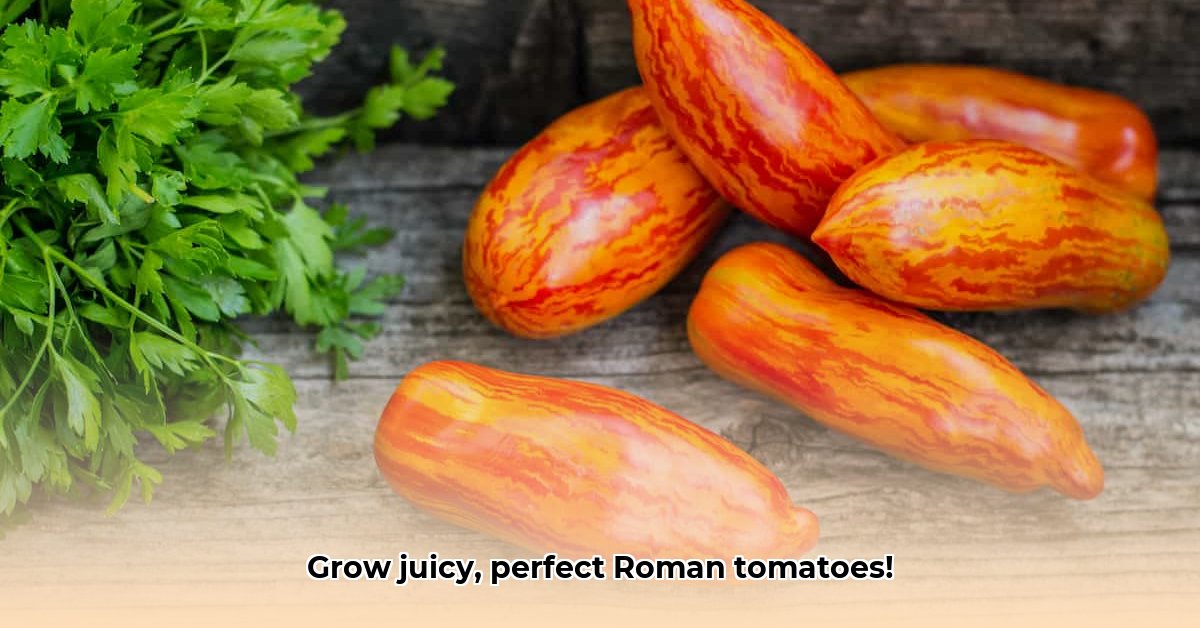Want to grow tons of delicious Roma tomatoes while being kind to the planet? This guide shows you exactly how. We’ll walk you through every step, from getting your soil ready to harvesting your juicy tomatoes, all while using sustainable methods. We’ll even cover how to deal with pests naturally and prepare your crops for a changing climate. You’ll learn how to work smarter, not harder, and discover who else benefits from your sustainable farming practices – because growing great tomatoes is about more than just a tasty harvest! For more on sustainable plant care, check out this helpful resource: Rio Plant.
Roman Tomato Cultivation: A Sustainable Farming Guide
Growing delicious and abundant Roman tomatoes doesn’t have to be a complicated affair. This guide walks you through sustainable practices that will yield a bumper crop, respect the environment, and bolster your bottom line. Let’s get started!
Understanding the Roman Tomato Plant and its Characteristics
The Roman tomato, also known as the Roma tomato, isn’t your average garden tomato. Its oblong shape, meaty texture, and lower water content make it ideal for sauces, pastes, and canning. The flavor is rich and concentrated—perfect for adding depth to your culinary creations. Sustainability when growing great Roman tomatoes requires a little planning and know-how. This guide provides everything you need to succeed for delicious Roma tomatoes. Romas typically grow to be about 3 inches long and are bright red, though new varieties come in a variety of colors.
Key Characteristics:
- Shape: Elongated, oblong, egg-like. Some varieties are plum-shaped or pear-shaped.
- Size: Approximately 3 inches in length.
- Texture: Meaty and dense with a thick fruit wall and skin.
- Flavor: Rich, concentrated, and tangy.
- Water Content: Lower than other tomato varieties, making them ideal for sauces and canning.
- Seed Count: Fewer seeds than other tomato types.
Sustainable Strategies for Thriving Roman Tomatoes
Sustainable farming isn’t just a trend; it’s smart gardening. It helps you reduce costs, improve yields, and protects the environment. Let’s dive into some key strategies for sustainable tomato farming:
1. Water Wisely: Roman tomatoes need water, but overwatering leads to problems. Drip irrigation is your friend. This targeted watering method delivers water directly to the roots, minimizing waste and ensuring efficient water use. Aim for 1 to 1.5 inches of water per week. Consider collecting rainwater – it’s free and beneficial. Choosing drought-tolerant varieties further reduces your water footprint.
2. Feed the Soil, Feed the Plants: Healthy soil is the secret ingredient for growing tomatoes. Think of it as a thriving ecosystem that supports your plants. Compost and other organic materials, like well-rotted manure, improve soil structure, fertility, and water retention. This reduces your reliance on chemical fertilizers, minimizing environmental impact and saving you money. A soil test can tell you what nutrients your soil might be lacking.
3. Natural Pest and Disease Management: Nobody wants pests or diseases ruining their harvest. Integrated Pest Management (IPM) is the answer. IPM focuses on preventing problems before they start. This might involve companion planting (planting certain plants together to deter pests), encouraging beneficial insects (ladybugs eat aphids!), and using pesticides only as a last resort and only when absolutely necessary.
4. Disease Prevention Is Key: Choose disease-resistant Roman tomato varieties whenever possible. These varieties are bred to be more resilient to common tomato diseases. Good air circulation is also crucial. Proper spacing between plants will help prevent fungal diseases from spreading. Sanitation is important, too; remove any diseased plants promptly and dispose of them properly. Regularly remove tomato suckers (or side shoots) while they are still small and can be snapped off easily
5. Support Systems for Happy Plants: Roman tomato plants are indeterminate growers, meaning they keep growing and producing fruit throughout the season. Provide support! Cages or stakes keep the plants upright, improve air circulation, and keep the fruit off the ground, preventing rot and making harvesting easier.
Optimizing Your Roman Tomato Harvest for Increased Yield
Maximizing yield and quality is paramount for a successful harvest.
1. Planting Density: Planting too many plants together is not ideal; the plants will compete for resources, resulting in smaller tomatoes and lower yields. Research the recommended spacing for your growing conditions, and experiment to find what works best in your garden.
- Determinate varieties: 12 to 24 inches apart.
- Indeterminate varieties: 2 to 3 feet apart.
- Row spacing: 4 to 6 feet apart.
2. Fertilizer: Less is Often More: Over-fertilizing can do more harm than good. Soil tests provide invaluable information on your soil’s nutrient levels. They guide you to apply the right amount of fertilizer, ensuring your plants receive the essential nutrients they need without excess.
3. The Power of Mulching: Mulching is a simple yet powerful technique. It suppresses weeds, conserves soil moisture (reducing watering needs), and regulates soil temperature, protecting plant roots from extreme temperatures. Experiment with different mulching materials (straw, wood chips, shredded leaves) to find what suits you best.
Who Benefits from Sustainable Roman Tomato Farming?
Sustainable farming benefits everyone involved in the process.
| Stakeholder Group | Benefits of Sustainable Roman Tomato Farming |
|---|---|
| Small-scale Farmers | Lower costs, better-quality tomatoes, easier market access, reduced reliance on expensive inputs |
| Large-scale Producers | Improved efficiency, enhanced brand reputation, environmental responsibility, long-term profitability |
| Consumers | Healthier, ethically grown food; support for local businesses, access to pesticide-free produce |
| Local Communities | Economic boost, environmental protection, improved food security, increased biodiversity |
| The Environment | Reduced pollution, healthier ecosystems, conservation of natural resources, improved soil health |
Final Thoughts: Growing Roman Tomatoes Sustainably
Growing Roman tomatoes sustainably isn’t just about eco-friendly practices; it builds a stronger, more profitable, and resilient farming system. By implementing these strategies, you’ll likely achieve a rich harvest while minimizing your environmental impact. Remember, sustainable farming is an ongoing journey of learning and adaptation. Keep exploring, experiment, and enjoy the fruits of your labor!
How to optimize Roma tomato fertilization for sustainable high yields
Key Takeaways:
- Balanced fertilization is key, shifting from high nitrogen initially to increased phosphorus and potassium during flowering and fruiting.
- Over-fertilizing harms fruit quality and the environment. Sustainable practices are crucial for sustainability in farming.
- Organic amendments like compost and aged manure improve soil health and reduce reliance on synthetic fertilizers.
Understanding Roma Tomato Nutrient Needs
Roma tomatoes, prized for their meaty texture and intense flavor, have specific nutrient requirements throughout their life cycle. Think of it like this: a young plant needs energy to build strong leaves (lots of nitrogen), while a mature plant needs nutrients for robust fruit production (phosphorus and potassium). Ignoring this fundamental truth is a recipe for disaster, as you’ll either have lush foliage and tiny tomatoes or weak plants that don’t produce well. Roma tomatoes thrive in slightly acidic soil with a pH between 6.2 and 6.8.
A Phased Approach to Fertilization
This isn’t a one-size-fits-all solution. The best approach involves a carefully planned multi-stage strategy.
Stage 1: Early Growth (Seedling to Early Vegetative): Focus on nitrogen (N) to fuel vigorous leaf development. A balanced fertilizer like 10-10-10 can work well, but always prioritize a soil test to determine your garden’s unique needs.
Stage 2: Vegetative Growth (Flowering): Shift the emphasis towards phosphorus (P) to promote strong root systems and flower development. A fertilizer with a higher phosphorus content, such as 10-20-10, might be more appropriate here.
Stage 3: Fruiting and Ripening: Potassium (K) is vital for fruit development and overall plant health. A fertilizer higher in potassium, perhaps a formulation like 5-10-15, can help you attain the luscious, full-bodied tomatoes you desire.
Sustainable Fertilization Practices
Sustainable agriculture isn’t just a trend; it’s a necessity. Here’s how to incorporate sustainable practices into your Roma tomato fertilization:
- Soil Testing: This is your first step; a soil test reveals existing nutrient levels, guiding accurate fertilizer application and preventing excess.
- Organic Amendments: Incorporate compost or aged manure before planting. These amendments boost soil health, improve water retention, and supply nutrients gradually, reducing the need for synthetic fertilizers.
- Precision Application: Avoid blanket fertilization. Use methods such as drip irrigation or side-dressing to deliver nutrients directly to the roots, minimizing environmental impact.
- Water Wisely: Overwatering can leach nutrients, diminishing their effectiveness. Practice efficient irrigation techniques.
- Crop Rotation: Rotate your tomatoes with other crops to avoid nutrient depletion and prevent pest and disease build-up.
- Foliar Feeding: Supplement soil fertilization with foliar sprays of micronutrients like magnesium and calcium. This can address deficiencies quickly.
Troubleshooting and Monitoring
Regular monitoring is essential. Are your plants exhibiting signs of nutrient deficiency (yellowing leaves, stunted growth)? Are the fruits small or misshapen? Adjust your fertilization strategy accordingly. Remember, you can always conduct another soil
- Gray Kitchen Backsplash Tile: Ideas for a Stylish Upgrade - December 14, 2025
- Backsplash For Gray Cabinets: Choosing the Right Backsplash Style - December 13, 2025
- Gray And White Backsplash: Ideas For Timeless Style - December 12, 2025









